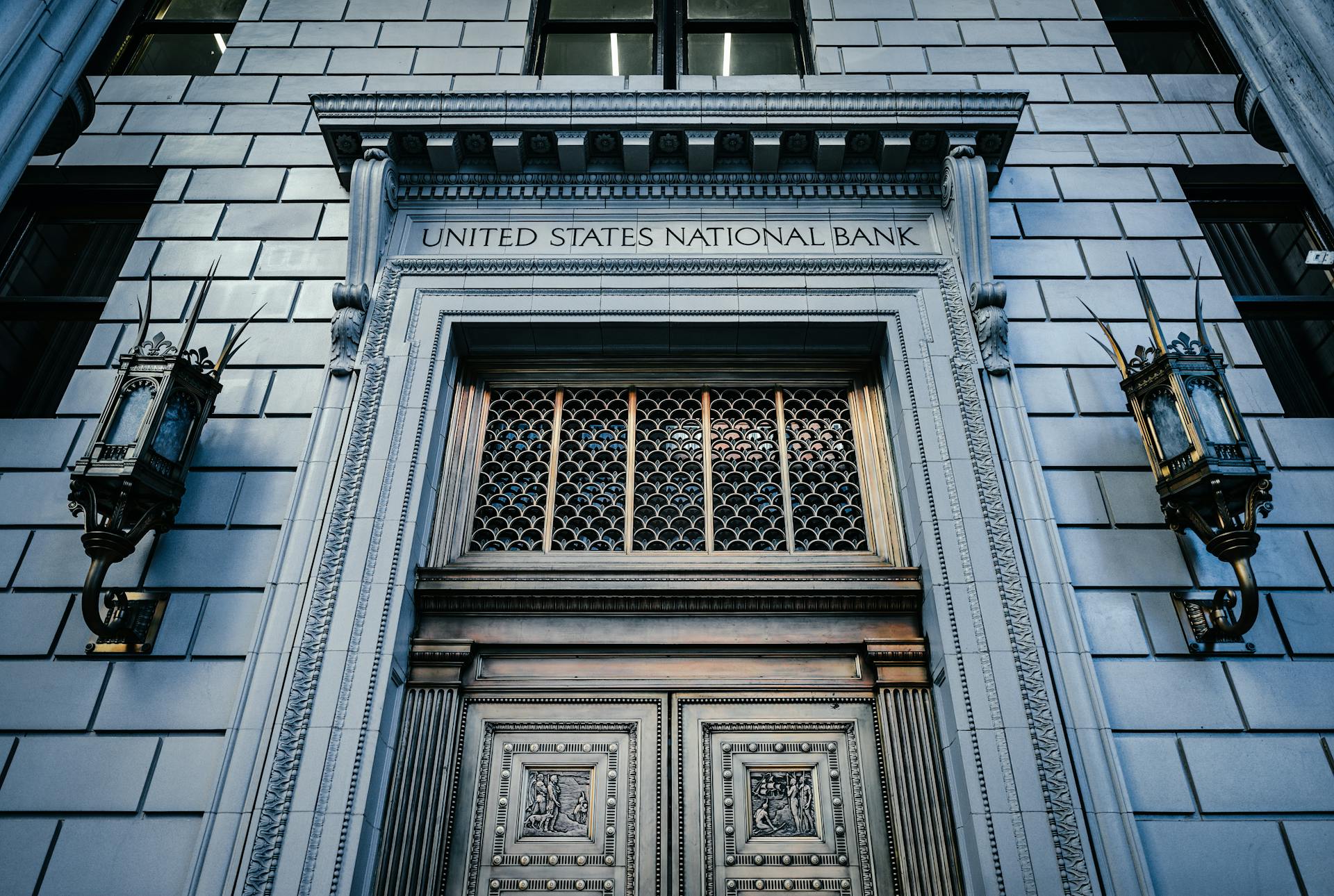
The Bank of Mongolia is the country's central bank and has been actively involved in maintaining financial stability.
It has been implementing various measures to strengthen the banking sector, including the provision of liquidity support to commercial banks.
One of the key initiatives is the introduction of a new risk management framework to enhance the resilience of the banking system.
The Bank of Mongolia has also been working to improve the country's payment systems, including the launch of a new interbank payment system.
Discover more: Problems with Td Bank Banking Payment System Complaints
Bank of Mongolia Overview
The Bank of Mongolia was opened on June 2, 1924, with a capital of 260,000 yanchaan and 22 employees, 18 of whom were Russian specialists. It was initially called the Trade and Industry Bank of Mongolia, but was later renamed to the Bank of Mongolia.
The bank faced difficulties in the first 18 months due to the absence of a national currency, and foreign currencies were used in circulation. It wasn't until February 22, 1925, that the Bank of Mongolia issued a new national currency, the Tögrög.
Explore further: Magyar Nemzeti Bank Currency

Today, the Bank of Mongolia has a strong presence in the country's economy, influencing monetary policy and contributing to the stabilization of the currency and reduction of inflation. As of 2012, it had US$2.9 billion in foreign reserves.
- Key milestones in the Bank of Mongolia's history:
- 1924: The Bank of Mongolia was opened with a capital of 260,000 yanchaan.
- 1925: The bank issued a new national currency, the Tögrög.
- 2012: The Bank of Mongolia had US$2.9 billion in foreign reserves.
History
The Bank of Mongolia has a rich history that dates back to 1924 when it was first established as a joint Mongolian-Russian bank. It was initially called the "Trade and Industry Bank of Mongolia" and had a single branch in Altanbulag.
At that time, the bank's capital was 260,000 yanchaan, and it operated with 22 employees, 18 of whom were Russian specialists and 4 were Mongolian. The bank's early years were marked by difficulties due to the absence of a national currency, which led to the use of foreign currencies in circulation.
In 1925, the Government of Mongolia issued a resolution to conduct monetary reform, and the Bank of Mongolia issued a new national currency called the Tögrög. This currency consisted of 25% precious metal and foreign stable currency, and 75% marketable goods.

The Bank of Mongolia's staff grew significantly over the years, increasing from 22 employees in 1924 to 98% of Mongolian staff in 1954. This led to the transfer of the former Soviet Union's share of capital and stocks in the bank to the state of Mongolia, resulting in the bank's name change to the State Bank of Mongolia.
In 1991, a new two-level banking system was established in Mongolia, and the Bank of Mongolia has since played a crucial role in maintaining the country's monetary policy and reducing inflation rates.
Curious to learn more? Check out: List of Banks That Have Merged to Form the State Bank of India
Ongoing Activities
The Bank of Mongolia has been actively involved in regulating the banking sector. It increased the minimum capital requirement for banks periodically, resulting in a capital adequacy ratio of 14-24 percent since 2000, which is 1.8-3 times higher than international minimum standards.
Private sector credit has seen significant growth due to strong economic conditions. Banks' total outstanding loans were MNT 60 billion in 2000, issued to 1700 borrowers, compared to MNT 2,000 billion issued to 483 thousand borrowers in September 2007.
The ratio of non-performing loans has fluctuated over the years. It fell to 3.5 per cent in September 2007, down from 24 per cent in 2000 and 50% in 1999, but rose again to 20% in 2009 before falling to 7.7% by June 2010.
The financial sector is fully privatized, with 16 banks, 141 non-bank financial institutions, and 131 savings and credit cooperatives operating in Mongolia.
Central Bank Decisions
The Central Bank of Mongolia, also known as the Bank of Mongolia, has made significant decisions to steer the country's economy. At its regular meeting, the Monetary Policy Committee (MPC) decided to maintain the policy interest rate at 10 percent.
In 2021, the MPC kept the policy rate unchanged at 6 percent, while issuing up to MNT 350.0 billion under the long-term repo financing in the second quarter. This move was aimed at mitigating the impact of the COVID-19 pandemic on the economy.
The MPC also decided to increase the minimum reserve requirement in both domestic and foreign currency by 1 percentage point, reaching 11 percent and 16 percent respectively in 2024. This move was aimed at preventing risk accumulation in the financial sector and ensuring financial stability.
Here's a summary of the MPC's decisions:
The MPC's decisions are aimed at stabilizing inflation at the target level and ensuring macroeconomic and financial stability over the medium term.
On Central Bank
Central banks play a crucial role in maintaining economic stability. They are responsible for implementing monetary policies to control inflation, stabilize exchange rates, and promote economic growth.
Their primary goal is to keep inflation low and stable, which is typically around 2-3% in most countries. This rate is considered optimal as it allows for economic growth without fueling inflation.
In times of economic downturn, central banks can lower interest rates to stimulate borrowing and spending. This can help boost economic growth by making loans cheaper and more accessible to businesses and individuals.
Worth a look: Australia Reserve Bank Cash Rate
Central banks also act as lenders of last resort, providing emergency loans to banks and other financial institutions during times of financial stress. This helps prevent bank failures and maintains confidence in the financial system.
The decisions made by central banks have a significant impact on the overall economy, making them a key player in shaping economic policy.
Decides to Maintain Policy Rate
The Central Bank of Mongolia has made some key decisions regarding the policy rate, and it's worth understanding what these mean for the economy.
The policy rate has been kept unchanged at 6 percent in 2021, which is a significant decision considering the economic environment at the time.
Annual headline inflation stood at 2.6 percent nationwide and 2.0 percent in Ulaanbaatar city as of February 2021.
The Bank of Mongolia decided to issue up to MNT 350.0 billion under the long-term repo financing in the second quarter of 2021, targeting businesses with more than 200 employees.
This decision was made to mitigate the impact of the COVID-19 pandemic on the economy.
In contrast, the policy rate was maintained at 10 percent in 2024, with the Central Bank of Mongolia expecting inflation to stabilize within the target range by 2026.
The economy grew by 5.0 percent in the first three quarters of 2024, but the growth forecast for 2024 was revised downward due to weakened activities in the construction and manufacturing sectors.
A table summarizing the policy rate decisions:
The Central Bank of Mongolia has shown a commitment to maintaining stable medium-term growth while avoiding excessive tightening of credit and financial conditions.
Frequently Asked Questions
Can a foreigner open a Bank account in Mongolia?
Yes, a foreigner can open a bank account in Mongolia with a written request and a passport. Most Mongolian banks also facilitate international money transfers.
What is the rating of Mongolia Bank?
Mongolia's credit rating is "B+" as of October 4, 2024, according to S&P and Fitch Ratings.
How many banks are there in Mongolia?
As of 2023, there are 13 commercial banks operating in Mongolia. Learn more about the banking system in this country.
Featured Images: pexels.com


